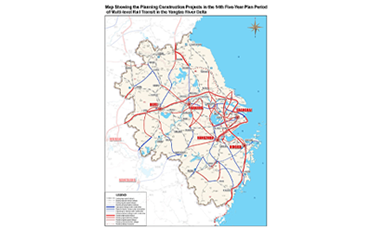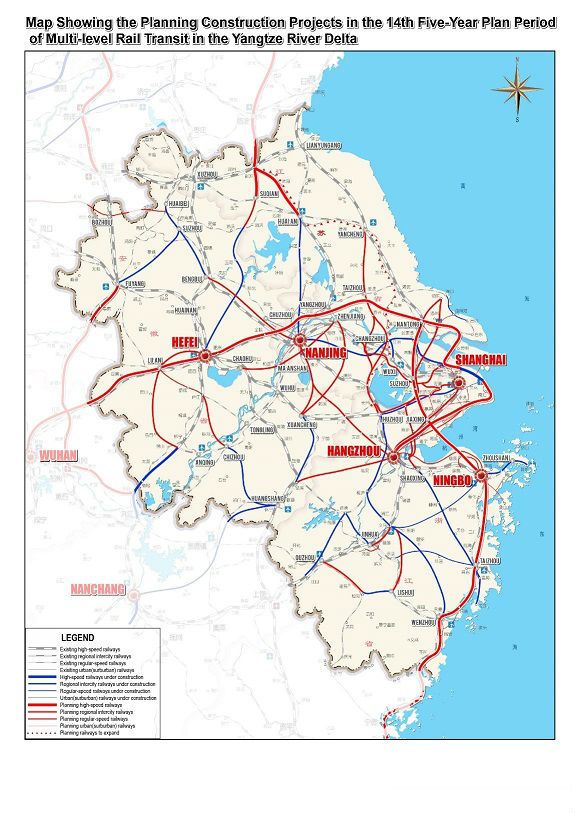



▲ Map Showing the Planning Construction Projects in the 14th Five-Year Plan Period of Multi-level Rail Transit in the Yangtze River Delta [National Development and Reform Commission/Translated by GUO Xinxin]
Introduction
Recently, in order to implement the strategic deployment of the "Outline of the Integrated Regional Development of the Yangtze River Delta", build the Yangtze River Delta on rail, promote the construction of a modern rail transit system with precise functional positioning, reasonable planning layout, clear network levels, and efficient integration, and support the integrated development of the region, the National Development and Reform Commission officially issued the "Multi-level Rail Transit Plan in the Yangtze River Delta".
According to the Plan, by 2025, the Yangtze River Delta’s rail transit network will be basically established; the total length of rail transit will reach about 22,000 km, with 8,000 km newly constructed; the high-speed railways will connect all the prefectural-level cities; the railways will connect all the cities with a permanent population of 200,000 or more; the rail transit service will cover 80% of cities and counties with a permanent population of 50,000 or more in urban areas.
By 2035, the Yangtze River Delta will be built on high-quality modern rail, build a multi-level network of rail transit service including trunk railways, intercity railways, urban and suburban railways and urban rail transit facilities, and achieve the goal of zero transfer at transport hubs, excellent operation service quality. The Yangtze River Delta will become a development demonstration zone of networked, integrated, intelligent, green rail transit, and the rail transit will lead and promote the development of regional integration.
Multi-level Rail Transit Plan in the Yangtze River Delta
Since the beginning of reform and opening up, especially since the 18th CPC National Congress, the development of rail transport in the Yangtze River Delta has entered a new stage of higher quality, higher level and higher standard. The rail transit network that connects cities, urban and suburban areas, regions, and the whole country is being accelerated built. The rail transport is more closely connected with civil aviation, highways and waterways. The transit hub stimulating effect will be further strengthened, and the provision ability and standards in rail transport service will be enhanced. These all play an important role in supporting the development of regional integration. At the same time, it is also faces the challenges such as unfair division of labor, network layout to be detailed, scale structure to be improved, integrated convergence to be enhanced, reform and innovation to be strengthened. In order to implement the strategic deployment of the "Outline of the Integrated Regional Development of the Yangtze River Delta", jointly build the Yangtze River Delta on rail and promote the integrated development of transport with higher quality, the "Multi-level Rail Transit plan of the Yangtze River Delta" has been prepared. The planning term is up to 2025 and offers visions into 2035.
1. Overall Requirements
(1)Guiding Ideology
To Guide with Xi Jinping Thought on Socialism with Chinese Characteristics for a New Era, fully apply the spirit of the 19th National Congress of the Communist Party of China and the second, third and fourth plenary session of the 19th Communist Party of China Central Committee, maintain the basic tone of seeking progress while maintaining stability, apply a new development philosophy and build a new development structure based on a new development stage, take the promotion of high-quality development as the theme, pursue furthering supply-side structural reform as the main task , take the reform and innovation as the basic inspiration, meet the people’s increasing needs for a better life as the fundamental purpose, take integration and high-quality as the key words, accelerate the construction of efficient and integrated modern rail transit system with accurate function, reasonable planning layout, clear network level, significantly enhance the level of rail coverage, rail transit integration and network, comprehensively improve the rail transit service quality, build the Yangtze River Delta on the rail based on the high starting point with high standard and high-performing, promote the construction of a modern comprehensive transport system, and prove strong support for promoting the development of regional integration.
(2)Basic Principles
To integrate and interconnect. To strengthen the integration and resource sharing of trunk railways, intercity railways, urban and suburban railways and urban rail transit facilities, coordinate system modes, technical standards, signage information, policies and regulations, promote the convergence of operation organization and transport service, and have a good overall network performance on efficiency and effectiveness.
To establish a scientific layout and provide solid support. To closely connect the relevant plans such as the territorial planning, strengthen the management of “one-map”, highlight the essence of “on rail”, coordinate the planning layout of different rail system, clarify functional positioning and division of labor, match supply and demand, reasonably set out the service interval, facility scale and the construction schedule, strengthen the leading support of rail transport to the development of regional integration.
To pursue green and intelligent, convenient and efficient development. To uphold the philosophy of service first, and emphasize the benefits of railway network in terms of safe and reliable, integrated and efficient, green and low-carbon, and major position in transport. To enhance the connection of rail transit with other modes of transport and achieve convenient transit, strengthen the application of modern information technology, optimize the coordination of transport organization, develop integrated, convenient, diversified, intelligent transport services.
To innovate and reform, to cooperate and achieve a win-win outcome. To expedite the establishment of institutional development mechanisms to adapt the integration of rail transport, provide a fair and open market access, encourage the local governments to strengthen the cooperation with rail enterprises or urban rail transport construction and operation enterprises, promote the innovation and reform in planning management, investment and construction, operation and organization, comprehensive development, etc.
2. Development Objectives
By 2025, the Yangtze River Delta on rail will be basically completed, forming a multi-level, optimally connected, and high-quality rail transit system for trunk railways, intercity railways, urban (suburban) railways, and urban rail transit. The Yangtze River Delta will become a demonstration and leading region for in-depth integration development of multi-level rail transit system, effectively supporting infrastructure interconnection and regional integration development. The length of rail transit will reach 22,000 km with over 8,000 km newly constructed. The high-speed railway lines will connect to all cities at prefecture or higher level. The railway lines will connect all the cities with a permanent population of more than 200,000. Rail transit services will cover 80% cities of more than 5,000 permanent residents in urban areas.
The operating mileage of trunk railways will reach about 17,000 kilometers, of which high-speed railways are about 8,000 kilometers. The arterial channel capacity will be comprehensively improved, forming a radical rail network with Shanghai, Nanjing, Hangzhou, Hefei, and Ningbo as pivot nodes, and the "three vertical and three horizontal" trunk channels as the principal arterials. A radial railway network facing north, west, and southwest, and forming a three hour-long interregional traffic circle between the Yangtze River Delta and neighboring urban agglomerations and provincial capitals.
The operating mileage of intercity railways will reach about 1,500 kilometers, and the intercity traffic circle between neighboring big cities in the Yangtze River Delta and Shanghai, Nanjing, Hangzhou, Hefei, Ningbo and surrounding cities forms a 1 to 1.5 hour-long intercity traffic circle.
The operating mileage of urban (suburban) railways will reach about 1,000 kilometers. The Shanghai metropolitan circle and the Nanjing, Hangzhou, Hefei, and Ningbo metropolitan circles form a 0.5 to 1 hour-long commuting traffic circle.
The operating mileage of urban rail transit will reach about 3,000 kilometers. Urban rail transit in Shanghai, Nanjing, Hangzhou, Hefei, Ningbo and other cities are running into a network. A number of cities have built the principal arterials of urban rail transit, and the proportion of urban rail transit in public transport is continuously increasing.
To build a number of comprehensive transportation hubs with integrated and efficient transfer of multiple rail transits. Some hubs will achieve multiple rail transit modes. The newly-built hubs basically achieve the same platform or three-dimensional transfer. The longest transfer time of different rail transit systems will be less than 5 minutes. The rail transit station yard and the large airport and highway passenger terminal can achieve the same station layout or rapid direct access, and the important hubs in the city can basically be reached within 0.5 hour.
Rail transit market-oriented investment and financing reforms will reach a new level. Different rail transit construction standards, regulations, and policies will be smoothly converged, and major breakthroughs will be made in the integrated operation and management mechanism. The sustainable development capacity of rail transit and the quality of transport services will be significantly improved.
By 2035, the Yangtze River Delta will be built on high-quality modern rails, and the Yangtze River Delta will become a network hub that connects zero transit and has excellent operational service quality through the layout of trunk railways, intercity railways, urban (suburban) railways, and urban rail transit facilities. Rail transit is a demonstration zone for integrated, intelligent, and green development of rail transit, and rail transit comprehensively leads and promotes the development of regional integration.
Source: UPSC & National Development and Reform Commission
Translated by Guo Xinxin